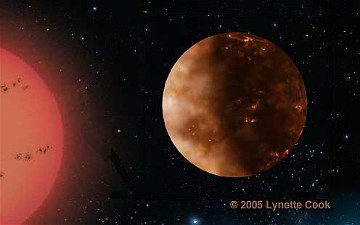A Few Words on Exoplanets

Over the last few years, advancements in the science of exo-planet discovery have allowed astronomers to detect smaller and smaller planetary bodies. Initial attempts at exo-planet discovery relied on a doppler shift seen in the light coming from a distant star as the star responded to the pull of gravity from an unseen planetary body whizzing about it. This resulted in the discovery of planets several times the size of Jupiter with orbits practically skimming the star's surface. Astronomers have speculated that these unseen planets are something that exist in the range of very large gas giants, big cousins of Jupiter or Saturn, or unrealized brown dwarf
stars.
Now, new techniques have developed to allow us to identify planets in the range of about 10 or less earth masses. These small planets are undoubtedly terrestrial type planets, which is to say they are primarily composed of rock with an iron core. In our solar system, the terrestrial planets are Mercury, Venus, Earth, and Mars. This is great news, and further refinement will undoubtedly result in the discovery of planets with masses very similar to Earth's. The problem is that the technical term "terrestrial" has been supplanted in the press by the term "earth-like", which conveys an entirely different meaning to the public at large. I think this was done by well-meaning astronomers in order to add spice to their press releases, but I'm not sure the public is benefiting. Let's examine two examples of the new "earth-like" exo-planets and see how closely they resemble our planet "Earth".
The "earth-like" exo-planet revolving around Gliese 876, named Gliese_876d, is only 6 to 8 times the mass of earth. This is far smaller than the Jupiter class planets previously discovered, but the surface gravity is between 1.8 and 2 times the surface gravity of earth, so if you weigh 140 pounds on earth, you'ld weigh between 252 and 280 pounds on Gliese_876d. The atmosphere could potentially be quite a bit thicker and heavier, assuming the planet had one. Not too bad so far, but let's continue. This planet orbits two million miles away from it's red dwarf sun, with an orbital period of 1.94 days. The sun in the sky would appear to be just a bit larger in size than a softball held at arm's length. To keep time there, you'ld just have to watch the star constellations zip by, assuming you were concerned with watching the clock. The problem is that the planet's rotation is most likely tidally locked to it's sun, meaning one side of the planet always faces the sun, so on that side of the world there is really only one time: noon. Being noon all the time, and being only 2 million miles away from a large thermonuclear furnace, the "noon-time" temperature is thought to be in the 200 to 400 degrees C range by astronomers, meaning that lakes of molten lead could exist there.
The far side of the planet, being in eternal darkness, would have the potential to be as cold as the darkest spot in space, just a few degrees above absolute zero, but that would be the case if no atmosphere were present. If the atmosphere consisted primarily of CO2, which would not be all that unlikely since most of the atmosphere's lighter gases may have dissipated into space due to the high temperatures on the day side, then the greenhouse effect would keep the planet uniformly hot, regardless of the lack of rotation. But assuming that the atmosphere hadn't completely dissipated or been reduced to primarily CO2 (very unlikely), the only place life might exist is close to the terminator between day and night, but I don't find this scenario very likely (Good stuff for science fiction, but not very likely in reality). The truth is, peculiarities of Gliese_876d make our own planets of Venus and Mercury look far more "earth-like" by comparison.
The next example of an "earth-like" exo-planet is OGLE-2005-BLG-390Lb, a planet that is 5 times the size of Earth orbitting it's red dwarf or white dwarf sun, orbitting about 2 to 4 times more distant than the Earth's orbit is from our sun. Since the planet's sun is very small, the surface temperature is theorized to be -220 degrees C, which puts it on par with the surface temperature of Pluto. Not even remotely conducive to life. The thing that makes this planet of interest at all is that it's size and orbit aren't that far out of the norm of what might be found in our own solar system, but from a layman's point of view this planet is nowhere near earthlike.
In my opinion, the term "Earth-like" should be reserved for planets that are something like Earth -- not for a giant version of Pluto, not for a bigger, hotter, faster version of Mercury, not a rotund version of Venus, but something like Earth. A place where living things might have a chance of existing. In my opinion, scientists should use the proper term "terrestrial" and then only if they define the term to mean a rocky planet with an iron core. Otherwise the term "earthlike" raises false hopes that we have found planets like our own. The good news with these announcements is that at least we're rapidly refining our ability to find planets orbitting around other stars, and that there are a lot of exo-planets out there and, eventually, we may actually find a planet worth calling "Earth-like".


0 Comments:
Post a Comment
<< Home